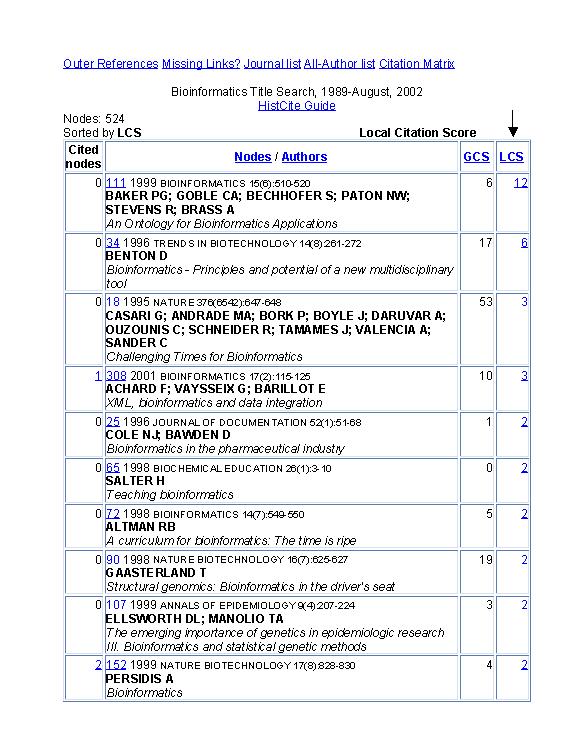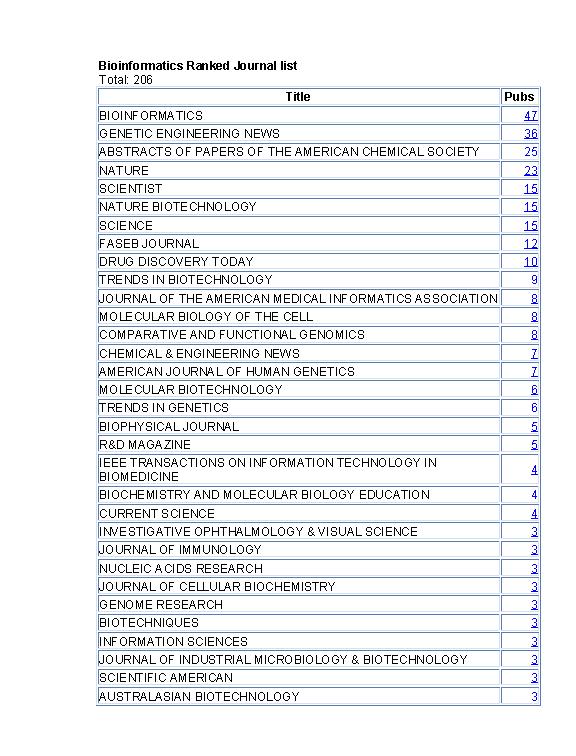When I first joined ASIS I had a continuing interest in medical and pharmaceutical documentation. After I left the Johns Hopkins Indexing Project, I became a consultant to Smith, Kline, French Laboratoratories � now Glaxo SmithKline. So it is not an accident that most significant ISI products are biomedically oriented. The first life sciences edition of Current Contents was entitled Current Contents of Chemical, Pharmaco-Medical & Life Sciences in 1958. In 1957, it had started as a custom service for Miles Laboratories. The Index Chemicus was inspired and launched in 1960 primarily for the pharmaceutical industry. In the decade that followed, my interests in ASIS and information retrieval reflected my early interest in what today is now called bioinformatics. This took expression in The Scientist, a news journal for the life scientist, which was founded in 1986. So when I became involved in ASIS again about four years ago, I felt that the society should be seizing the opportunity presented by this exponentially growing field.
Fortunately, in pursuing the development of SIG Bioinform I met Greg Paris who not only expressed interest in the idea of a bioinformatics SIG; he seemed to fully understand the relationship between information science and this new field. I am glad that Greg has stuck with this and that we have now progressed to the point of operating a listserve. I presume this symposium is the first of several activities that will be the result of this new SIG and I look forward to an ASIST summit on bioinformatics.
My primary interest in establishing this SIG was motivated by wanting to promote new membership in ASIST. Over the years we have lost significant contact with people in the biotech/pharmaceutical world. In the early days, ASIS was attractive to many professionals involved in science information systems. The evolution from documentation to an information science orientation affected many of these people. In the few years that have now elapsed since we first began organizing this SIG, for which there was initially very little interest, the field of bioinformatics has forged ahead. Not surprisingly, the literature of bioinformatics has grown significantly. So one of my first acts as Chair Pro-Tem was to post abstracts of the current literature on the SIG listserve. To give you further insight on this literature, I�ve provided an analysis using the HistCite software on which I reported on Monday, here at ASIS 2002.
SLIDE 1: HISTCITE OF ARTICLES ON BIOINFORMATICS
The first slide is the standard chronological display. Time does not permit me to go into details so I�ve prepared a short handout which includes copies of the screens you would see in a live demo. Hopefully we will be able to access the file here dynamically, either online or via CD-ROM. If not, you can go to the URL on my website at Penn (http://garfield.library.upenn.edu/histcomp/bioinformatics_03-20-03/ - updated 03-20-03).
The analysis shows that the field is less than ten years old even though there were a few papers using this term before then. It also illustrates the dispersal of the literature � there is relatively little interlinking of papers as shown in the Local Citation Scores (LCS) and Global Citation Scores (GCS) where the number of papers that neither cite nor are cited by the collection is very large (zeros). The GCS is the number of times the paper is cited in the ISI Web of Science.. The LCS is the number of times the paper is cited in the collection.
SLIDE 2: BIOINFORMATICS - LOCAL CITATION SCORE
The second slide is sorted by the local citation score. The most-cited paper in the local network is Barber et al on �An Ontology for Bioinformatics Applications.� (12 Cites) whereas the most-cited paper globally is a paper by D. L. Rossi titled �Identification through bioinformatics of two new macrophage proinflammatory human chemokines � MIP-3 alpha and MIP-3 beta.
SLIDE 3: BIOINFORMATICS � GLOBAL CITATION SCORE
Slide 3 shows the Global Citation sort. Note the dominance of genomics papers.
SLIDE 4: GRAPH OF BIOINFORMATICS LITERATURE
The HistCite historiography of this collection shows how few interconnections there are as yet in this field. You might say it�s citation classics have not yet emerged.
SLIDE 5: RANKED JOURNAL LIST
This should speak for itself.
Undoubtedly, this preliminary analysis suffers from the simplistic approach of searching on one keyword rather than focusing on the relatively few key papers in bioinformatics. These will become more evident as the field matures.
References:
a. Garfield E. �The Dissemination of Current Research through a Cooperative Contents Page-Abstracting Service,� paper presented at the annual meeting of the American Documentation Institute, New York, December 28-29, 1956.
http://garfield.library.upenn.edu/papers/29.htmlb. Garfield E. �Copyright, Contents Pages, Cooperation, Conscience�Necessary Ingredients for the Effective Dissemination of Scientific Information,� paper presented at the Annual Symposium of the Library of the Chemists Club, New York, April 28, 1959.
http://garfield.library.upenn.edu/papers/percolator35(1)p19y1959.htmlc. Garfield, E. "From Laboratory to Information Explosions..The evolution of Chemical Information Services at ISI. Presentation at the ASIS meeting on "Historical Perspectives on Knowledge Dissemination," Washington D.C., November 1, 1999. Reprinted in Journal of Information Science, 27(2) p.119-125, April 2001.
http://garfield.library.upenn.edu/papers/jis27(2)p119y2001.pdfd. Garfield E. �The Human Side of Science,� The Scientist 1(3):9 (December 15, 1986).
http://www.the-scientist.com/yr1986/dec/comm_861215.html




